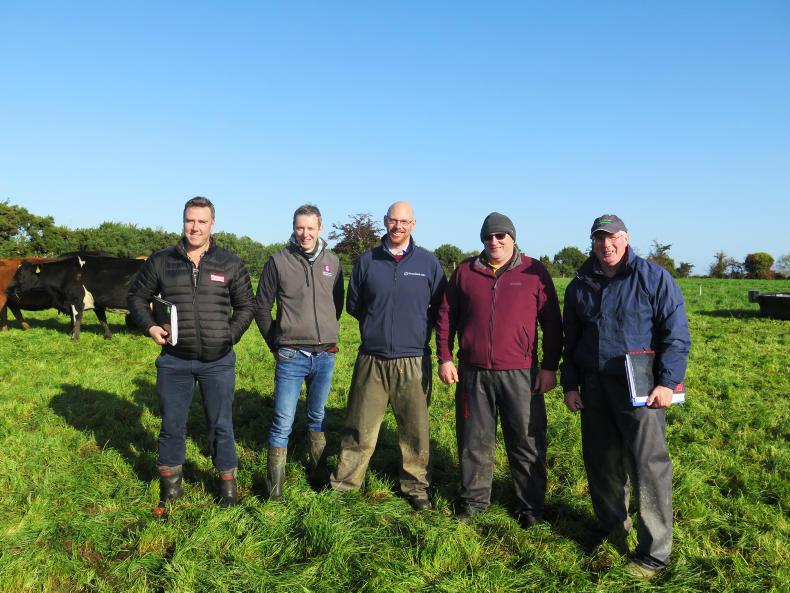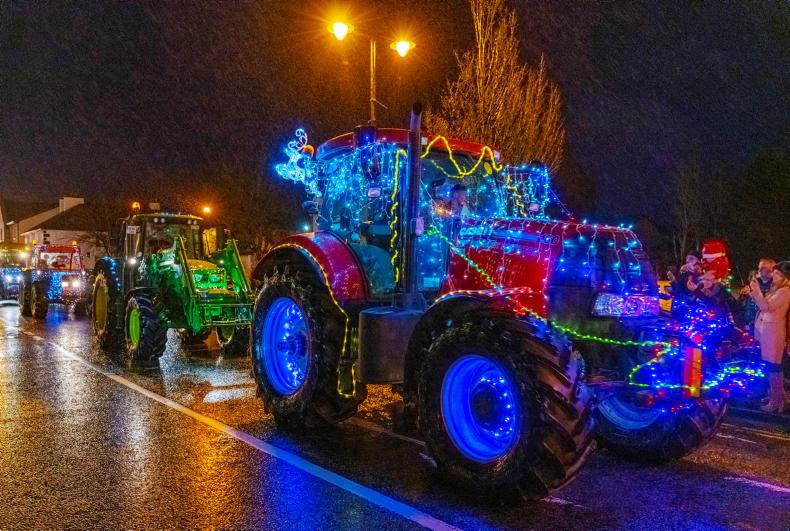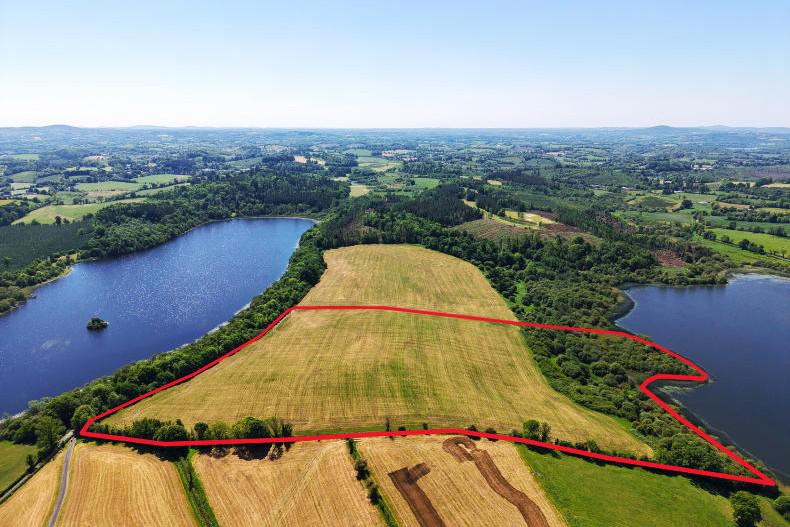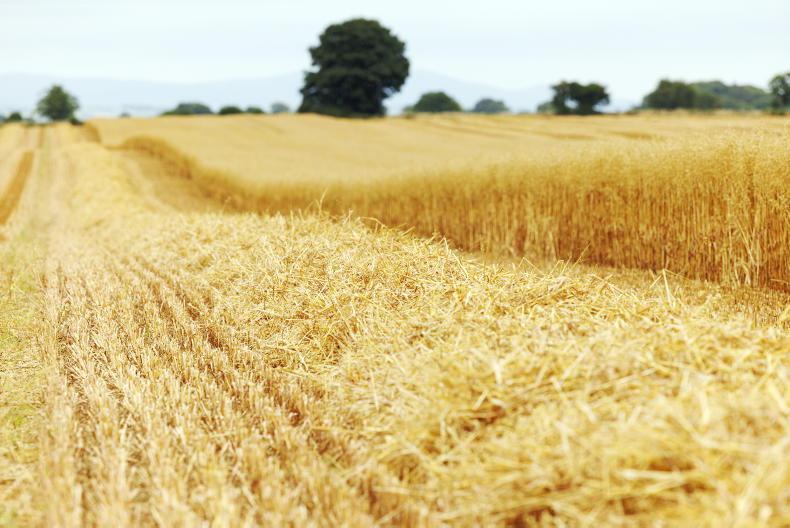
Conor Kelleher, Aherla, Bandon, Co Cork.
Bandon, Co Cork
A new roadway linking a 15ha outblock with the 43ha home block has completely changed the dynamics on Conor Kelleher’s Cork farm. On the face of it, this roadway seems like a no-brainer idea, but you need to visit the farm to see the complexity involved in creating it. A deep glen, like the type found all over this part of Cork, divided the farm in two.
Even though all the land in between the two blocks is owned, the severity of the glen along with the river and minor road that run through it meant that for decades, the Kellehers accessed the land via public roads, rendering the glen inaccessible to their herd of 140 cows.

The new road through the glen on Conor Kelleher's farm.
That all changed this summer, when Conor finally got the courage to build a road through the glen. Rather than going straight down, the new road is at an angle and cut into the sides of the glen, reducing the steepness of the slope. A new bridge over the stream and an underpass under the road was also built. The investment has linked the two land blocks and there are now 58ha in the milking block. The plan is to increase cow numbers to 170.
Like all the finalists in this competition, grass growth is good, with an average of 15.5t/ha grown over the last three years. Like most farmers, 2018 was a challenging year and extra meal had to be fed and silage had to be bought in. In 2019, Conor has concentrated on improving grass utilisation. He targeted a lower peak cover of less than 1,000kg/ha in mid-September to see if utilisation and growth rate would be improved by grazing lighter covers. His target closing cover is 750kg/ha on 1 December.

Paudie O'Brien, Firies, Co Kerry.
Firies, Co Kerry
New entrant to dairying Paudie O’Brien has sent shockwaves through the farming community in mid-Kerry. The panel-beater-turned-dairy farmer is outperforming most farmers in the country, let alone the county. He inherited his uncle’s farm in 2005 and set up a 30 cow suckler herd until 2013, when he was a recipient of the new entrant milk quota. He started with 30 dairy cows and today he is milking 76 cows and growing 15tDM/ha, on what would be considered by most to be a very heavy farm in a high rainfall area.

Paudie O'Brien's cows out grazing in Firies, Killarney, Co Kerry.
Paudie is a passionate manager of grass. He says that measuring grass weekly is as natural as measuring how much silage you have before the winter. The milking platform extends to 30ha, with some of this leased. When the new leases were taken on, he drained, reseeded and invested in roadways and water troughs to improve grazing infrastructure. The farm is very well laid out with plenty of access points. Paudie puts a huge emphasis on soil fertility. pH has been all but corrected bar two paddocks. Phosphorus index has gone from the farm being almost 90% at index one and two in 2017 to being 50% index three today. Potash has followed an even greater trajectory, whereby 80% was at index one and two in 2017 but now 80% is at index three and four. It goes to show what’s possible when you put emphasis on something.
Paudie is part of the Kerry/McDonalds soil fertility project. Every paddock is sampled annually and all records of fertiliser that is applied is uploaded to PastureBase, so a record is kept of what is applied in each paddock. The farm has all the appearance of a thriving land. When the judges visited in mid-October, the weather was horrendous, with many herds in the area housed. Yet, Paudie’s cows were out grazing and weren’t leaving a mark, despite the fact that much of the land was saturated;
“I have my go-to paddocks for days like this. I wouldn’t dream of grazing a wet paddock on a wet day, much better to keep that for a dry day. From walking the farm weekly I know every inch of the farm and if it means I have to walk the cows to a far section of a paddock then I’ll do that.” Paudie says.
Every paddock on the farm was cut and baled at least once in 2019, with either slurry or two bags/ac of 10:10:20 targeted to those fields after cutting, to replace the offtakes. Bales are colour coded so he can pick out the good bales from the middling bales if milking cows need to be fed silage.
He reseeds 10% of the farm per year, using mostly Kerry Agribusiness high performing grass mixtures. There was an average of 50 grass walks completed over the last three years. After doing a grass walk in the mid-season, Paudie says he’s comfortable if farm cover is between 160 and 170kg/cow. He doesn’t graze covers higher than 1,580kg/ha. His long term plan is to continue to develop and improve the farm. Performance from the herd is good with 478kgMS/cow produced in 2018.

Owen Brodie.
Kingscourt, Co Cavan
Farming on the banks of Lough Ramor in Co Cavan, Owen Brodie is milking 194 cows on a 59ha milking platform. Performance is excellent, with grass growth averaging 15.5tDM/ha over the last three years. The challenge on this farm is the topography, with the top of the farm 2.3km from the yard and up a steep slope. Cows are on track to produce 440kgMS/cow in 2019 from an expected 500kg of meal.

A newly planted hedgerow on Owen Brodie's farm overlooking Lough Ramor.
The herd is primarily Jersey crossbred and Owen has been criss-crossing these back and forth with high EBI Holstein Friesian genetics. Calving start date is around 6 February and 90% are expected to calve in six weeks.
The stocking rate on the home block is high at almost 3.3 cows/ha, but a new support block of 50ac was purchased in late 2018, which is 12 miles away from the home block. Overall stocking rate is now 2.6 cows/ha. Before the land was purchased, Owen used to be short about 20% of his winter feed, so this was purchased in. Now the farm is more than self-sufficient.
One third of the slurry produced on the farm is spread in February, with more spread in April. All slurry is spread using either a dribble bar or a trailing shoe. Owen is conscious of the environment and has planted new hedgerows and trees around the farm.
Read more
Dairy Day: how to get there and what to expect
Dairy Day: top tips for hassle-free calf rearing

Conor Kelleher, Aherla, Bandon, Co Cork.
Bandon, Co Cork
A new roadway linking a 15ha outblock with the 43ha home block has completely changed the dynamics on Conor Kelleher’s Cork farm. On the face of it, this roadway seems like a no-brainer idea, but you need to visit the farm to see the complexity involved in creating it. A deep glen, like the type found all over this part of Cork, divided the farm in two.
Even though all the land in between the two blocks is owned, the severity of the glen along with the river and minor road that run through it meant that for decades, the Kellehers accessed the land via public roads, rendering the glen inaccessible to their herd of 140 cows.

The new road through the glen on Conor Kelleher's farm.
That all changed this summer, when Conor finally got the courage to build a road through the glen. Rather than going straight down, the new road is at an angle and cut into the sides of the glen, reducing the steepness of the slope. A new bridge over the stream and an underpass under the road was also built. The investment has linked the two land blocks and there are now 58ha in the milking block. The plan is to increase cow numbers to 170.
Like all the finalists in this competition, grass growth is good, with an average of 15.5t/ha grown over the last three years. Like most farmers, 2018 was a challenging year and extra meal had to be fed and silage had to be bought in. In 2019, Conor has concentrated on improving grass utilisation. He targeted a lower peak cover of less than 1,000kg/ha in mid-September to see if utilisation and growth rate would be improved by grazing lighter covers. His target closing cover is 750kg/ha on 1 December.

Paudie O'Brien, Firies, Co Kerry.
Firies, Co Kerry
New entrant to dairying Paudie O’Brien has sent shockwaves through the farming community in mid-Kerry. The panel-beater-turned-dairy farmer is outperforming most farmers in the country, let alone the county. He inherited his uncle’s farm in 2005 and set up a 30 cow suckler herd until 2013, when he was a recipient of the new entrant milk quota. He started with 30 dairy cows and today he is milking 76 cows and growing 15tDM/ha, on what would be considered by most to be a very heavy farm in a high rainfall area.

Paudie O'Brien's cows out grazing in Firies, Killarney, Co Kerry.
Paudie is a passionate manager of grass. He says that measuring grass weekly is as natural as measuring how much silage you have before the winter. The milking platform extends to 30ha, with some of this leased. When the new leases were taken on, he drained, reseeded and invested in roadways and water troughs to improve grazing infrastructure. The farm is very well laid out with plenty of access points. Paudie puts a huge emphasis on soil fertility. pH has been all but corrected bar two paddocks. Phosphorus index has gone from the farm being almost 90% at index one and two in 2017 to being 50% index three today. Potash has followed an even greater trajectory, whereby 80% was at index one and two in 2017 but now 80% is at index three and four. It goes to show what’s possible when you put emphasis on something.
Paudie is part of the Kerry/McDonalds soil fertility project. Every paddock is sampled annually and all records of fertiliser that is applied is uploaded to PastureBase, so a record is kept of what is applied in each paddock. The farm has all the appearance of a thriving land. When the judges visited in mid-October, the weather was horrendous, with many herds in the area housed. Yet, Paudie’s cows were out grazing and weren’t leaving a mark, despite the fact that much of the land was saturated;
“I have my go-to paddocks for days like this. I wouldn’t dream of grazing a wet paddock on a wet day, much better to keep that for a dry day. From walking the farm weekly I know every inch of the farm and if it means I have to walk the cows to a far section of a paddock then I’ll do that.” Paudie says.
Every paddock on the farm was cut and baled at least once in 2019, with either slurry or two bags/ac of 10:10:20 targeted to those fields after cutting, to replace the offtakes. Bales are colour coded so he can pick out the good bales from the middling bales if milking cows need to be fed silage.
He reseeds 10% of the farm per year, using mostly Kerry Agribusiness high performing grass mixtures. There was an average of 50 grass walks completed over the last three years. After doing a grass walk in the mid-season, Paudie says he’s comfortable if farm cover is between 160 and 170kg/cow. He doesn’t graze covers higher than 1,580kg/ha. His long term plan is to continue to develop and improve the farm. Performance from the herd is good with 478kgMS/cow produced in 2018.

Owen Brodie.
Kingscourt, Co Cavan
Farming on the banks of Lough Ramor in Co Cavan, Owen Brodie is milking 194 cows on a 59ha milking platform. Performance is excellent, with grass growth averaging 15.5tDM/ha over the last three years. The challenge on this farm is the topography, with the top of the farm 2.3km from the yard and up a steep slope. Cows are on track to produce 440kgMS/cow in 2019 from an expected 500kg of meal.

A newly planted hedgerow on Owen Brodie's farm overlooking Lough Ramor.
The herd is primarily Jersey crossbred and Owen has been criss-crossing these back and forth with high EBI Holstein Friesian genetics. Calving start date is around 6 February and 90% are expected to calve in six weeks.
The stocking rate on the home block is high at almost 3.3 cows/ha, but a new support block of 50ac was purchased in late 2018, which is 12 miles away from the home block. Overall stocking rate is now 2.6 cows/ha. Before the land was purchased, Owen used to be short about 20% of his winter feed, so this was purchased in. Now the farm is more than self-sufficient.
One third of the slurry produced on the farm is spread in February, with more spread in April. All slurry is spread using either a dribble bar or a trailing shoe. Owen is conscious of the environment and has planted new hedgerows and trees around the farm.
Read more
Dairy Day: how to get there and what to expect
Dairy Day: top tips for hassle-free calf rearing















SHARING OPTIONS